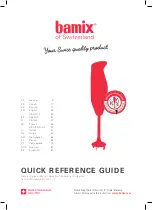
5
Safety and Warranty
2. Never use the meat mixer without the clear lid in place.
3. The meat mixer is not a toy. Keep children away. Never leave the meat mixer unattended.
4. Always remove the handle from the meat mixer when not in use.
5. Thoroughly inspect the meat mixer before each use. If any parts are missing, damaged or do not function
properly, contact Omcan.
6. Do not mix bones or other hard objects that could damage the mixing shaft.
7. The manufacturer declines responsibility for any improper use of the meat mixer.
8. Only use the meat mixer on a stable, level surface. The meat mixer should not move or shift during use.
9. Tie back loose hair and clothing, roll up long sleeves and remove ties and jewelry including watches, rings
and bracelets before operating the meat mixer.
10. Thoroughly wash all meat mixer parts that contact food in warm, soapy water before and after each use.
Rinse with clear water. Dry all parts before re-assembly and storage. The meat mixer is not dishwasher
safe. It is best to use a food-grade silicone spray to coat all metal parts.
11.
Do not use the meat mixer while under the influence of drugs or alcohol.
12. Save these instructions.
FOOD SAFETY
COOK
It’s crucial to cook food to a safe internal temperature to destroy bacteria that is present. The safety of
hamburgers and other foods made with ground meat has been receiving a lot of attention lately, and with good
reason. When meat is ground, the bacteria present on the surface is mixed throughout the ground mixture. If
this ground meat is not cooked to at least 160°F to 165°F (71°C to 74°C), bacteria will not be destroyed and
there’s a good chance you will get sick.
Solid pieces of meat like steaks and chops don’t have dangerous bacteria like E. coli on the inside, so they can
be served more rare. Still, any beef cut should be cooked to an internal temperature of at least 145°F (63°C)
(medium rare). The safe temperature for poultry is 180°F (82°C) and solid cuts of pork should be cooked to
160°F (71°C). Eggs should be thoroughly cooked too. If you are making a meringue or other recipe that uses
uncooked eggs, buy specially pasteurized eggs or use prepared meringue powder.
SEPARATE
Foods that will be eaten uncooked and foods that will be cooked before eating MUST ALWAYS be separated.
Cross-contamination occurs when raw meats or eggs come in contact with foods that will be eaten uncooked.
This is a major source of food poisoning. Always double-wrap raw meats and place them on the lowest shelf in
the refrigerator so there is no way juices can drip onto fresh produce. Then use the raw meats within 1-2 days
of purchase, or freeze for longer storage. Defrost frozen meats in the refrigerator, not on the counter.
When grilling or cooking raw meats or fish, make sure to place the cooked meat on a clean platter. Don’t use
the same platter you used to carry the food out to the grill. Wash the utensils used in grilling after the food is
turned for the last time on the grill, as well as spatulas and spoons used for stir-frying or turning meat as it
cooks.
Make sure to wash your hands after handling raw meats or raw eggs. Washing hands with soap and water, or
using a pre-moistened antibacterial towelette is absolutely necessary after you have touched raw meat or raw


































